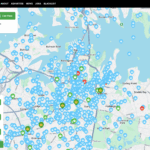Joanne Gambale did not set out to become a stylist – or an activist.
As a budding journalist, she cut her teeth at newspapers before moving into magazines, where a chance sub-editing job landed her at Vogue Living.
But she never fully felt part of the haute couture set.
“The fashion office was very cliquey,” the 47-year-old recalls. “I was obsessed with vintage, but in that environment it felt a bit off-centre.”
Her perspective shifted during a family trip when she read Claire Press’ Wardrobe Crisis, a book that lays bare the environmental impact of the clothing industry.
“It was life-changing,” Gambale says. “I realised I had been shopping sustainably for years without even knowing it. That was the ‘aha moment’ that pushed me towards creating something new.”
That “something new” began with Slogue, her personal styling business, where she helps clients curate wardrobes built on longevity, creativity, and secondhand finds. But Gambale quickly realised adults often slipped back into old habits.
“I would return months later and they had bought more fast fashion,” she admits. “It was dismaying. I wanted to make real change.
“I realised I could make more impact teaching ‘pre-consumers’ – kids – just about to enter their teenage years.
“That’s when habits are formed, and when we need to challenge the fast fashion mindset.”
Through her initiative Flip Fashion Forever, she began building an education-focused movement that empowers young people to create, repair, and rethink their relationship with clothing.
Today, the program runs youth-led sewing and styling workshops in Sydney’s Inner West that teach tweens and teens how to upcycle, mend, and create with textiles. Instead of rigid lessons, the program encourages experimentation.
We already have enough clothes to clothe the next six generations … we need to shift education so kids see textiles as resources, not disposable.
“We are not telling them what they are doing is wrong,” Gambale says in regards to the quality of the upcycling. “The mentors guide them, but the kids feel confident and empowered just to try.”
For young fashion designer and crocheter Siobhan Killen, 21, working with Gambale has been transformative.
“Jo’s been a really fantastic person to work with,” she says. “My career goal has always been simple: get paid to talk about something I care about, and I’ve been able to achieve that at such a young age because of the work Jo does.
“It’s really significant to me to have been given the opportunity to work in an area I care so much about.”
She believes Gambale’s model is uniquely empowering.
“Rather than buying the products young fashion designers make, she focuses on getting them speaking and teaching opportunities, which is a lot easier to make money from,” says Killen.
“The holiday programs Jo runs support young designers and build a community of likeminded creatives of all ages, which I think we really need.”
Gambale’s work has caught wider attention. Earlier this year, Better Homes and Gardens filmed a feature on one of her camps. Yet Gambale admits running a grassroots initiative is far from glamorous.
She wears “a hundred hats,” from PR and marketing to grant-writing and event organising, and dreams of scaling the concept into schools across Australia.
“We already have enough clothes to clothe the next six generations,” she says. “The real issue is overproduction. We need to shift education so kids see textiles as resources, not disposable.”
For Gambale, the dream is bigger than her own workshops. She envisions a future where textiles are part of everyday education, and where creativity replaces consumption as the driving force in fashion.
“My ambitions might be too big,” she laughs. “But if kids leave my workshops seeing clothes differently, then that is already a win.”
Main image of Joanne Gambale by Bronte Harb.




























